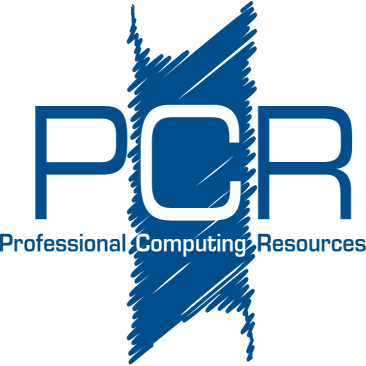G/L Accounts (GLA) Tabs
This is a listing of all the tabs a User might encounter in the 'G/L Accounts' Catalog. To access the GLA Catalog, navigate to Main > Catalog > G/L Accounts (GLA).
Account Management
If the application is licensed for Accounts Receivable and when an AR flagged GLA is selected, the 'Account Management' tab is displayed. This tab allows for display and management of the Monthly AR Balances (Current, 30, 60, 90, 120+), the AR Type and Status fields, and the Email Invoice flag.
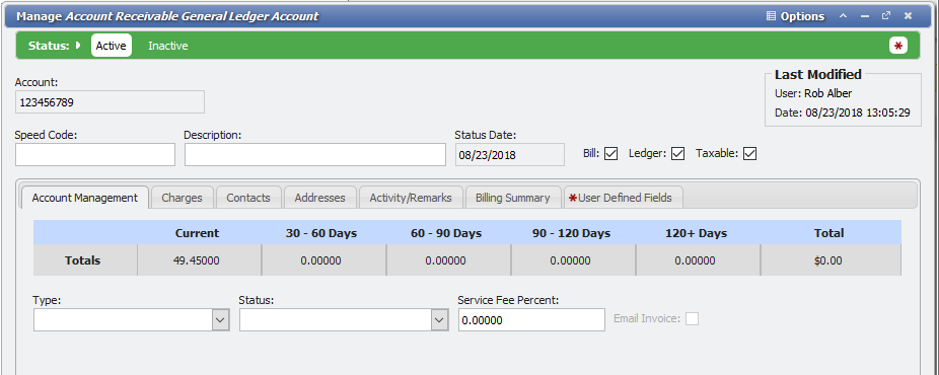
Type
The 'Account Type' field is informational only; there is no logic tied to this field. The options here are driven by the system List Type 'AR_TYPE'. Additional options can be added from the List Values grid at Admin > System Tables > List Values.
Status
The 'Account Status' field is informational only; there is no logic tied to this field. The options here are driven by the system List Type 'AR_STATUS'. Additional options can be added from the List Values grid at Admin > System Tables > List Values.
Service Fee Percentage
During the Bill process, each AR account is assessed a Service Fee based on this field. If the field is empty or zero, no fee is assessed. The process uses a special System Use Charge Catalog called 'Service Fee' and generates billing transactions using the primary GLA Contact, the Service Fee Description, and a Transaction Date matching the Bill Generation date. The Transaction Amount is calculated based on the Service Fee Percentage of the Invoice total for that Bill.
Email Invoice
The 'Email Invoice' flag provides the ability to opt-in or out of the automated Invoice Email process that can be used to email all AR accounts with Invoices on a specific Bill. The default state for this flag is off. The Email Invoice flag is only available if the specific GLA has a Primary Contact, and that Contact has a Primary Email. If there is not a Primary Contact with a Primary Email assigned to the GLA, the field is unchecked and read-only.
Charges
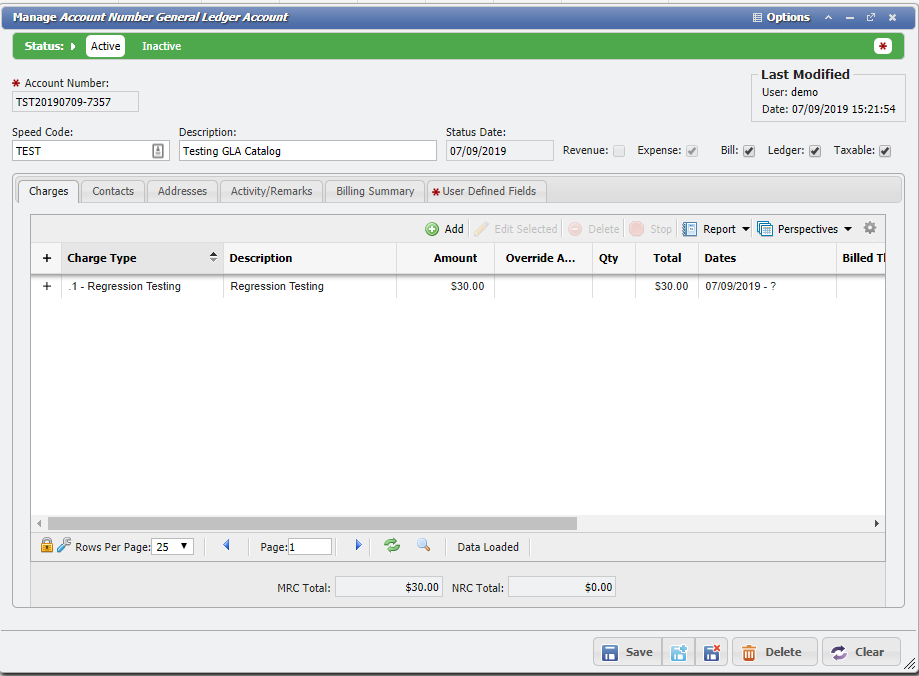
Charges Tab
The Charges tab provides the User access to manually control if a Charge is associated with a GLA. There are four functions that can be used to control these charges: 'Add', 'Edit', 'Delete', and 'Stop'.
PCR-360 contains two different types of Charges.
Recurring: Charges that recur over time for continued usage of a piece of Equipment or Service. There are four types of Recurring Charges for Organizations to base their Billing practices on.
Monthly: This is the default for a Charge's Charge type. The Charge will be applied every month until it is stopped.
These Charges can be set to "Bill Forward", thus Bill one month ahead of the Billing Cycle.
These Charges can also be set to 'Bill Backward' in order to catch up on past Billing Cycles.
When the GLA for this Charge is updated, the Charge is Stopped and Restarted.
If Selective Billing was used in the Charge Catalog, some of the Months may not be billed. Also, if Selective Billing is used, "Bill Forward" and "Bill Backward" will be disabled.
Quarterly: The Charge will be applied every three months until it is stopped.
These Charges are always treated as being set for "Bill Forward".
Back Dated Charges will Bill for one cycle only, before continuing on the current cycle.
Example, a Charge backdated six months ago, will Bill for only the last three months.
When the GLA for this Charge is updated, the Charge is Stopped and a new Charge is Started.
The Effective Date for updates to this type of Charges can only be set for the date of the Last Billed.
Semi-Annual: The Charge will be applied every six months until it is stopped.
These Charges are always treated as being set for "Bill Forward".
Back Dated Charges will Bill for one cycle only, before continuing on the current cycle.
Example, a Charge backdated twelve months ago, will Bill for only the last six months.
When the GLA for this Charge is updated, the Charge is Stopped and a new Charge is Started.
The Effective Date for updates to this type of Charges can only be set for the date of the Last Billed.
Annual: The Charge will be applied every twelve months until it is stopped.
These Charges are always treated as being set for "Bill Forward".
Back Dated Charges will Bill for one cycle only, before continuing on the current cycle.
Example, a Charge backdated three years ago, will Bill for only the last year.
When the GLA for this Charge is updated, the Charge is Stopped and a new Charge is Started.
The Effective Date for updates to this type of Charges can only be set for the date of the Last Billed.
Non-Recurring: One-Time Only Charges.
Add
After clicking the
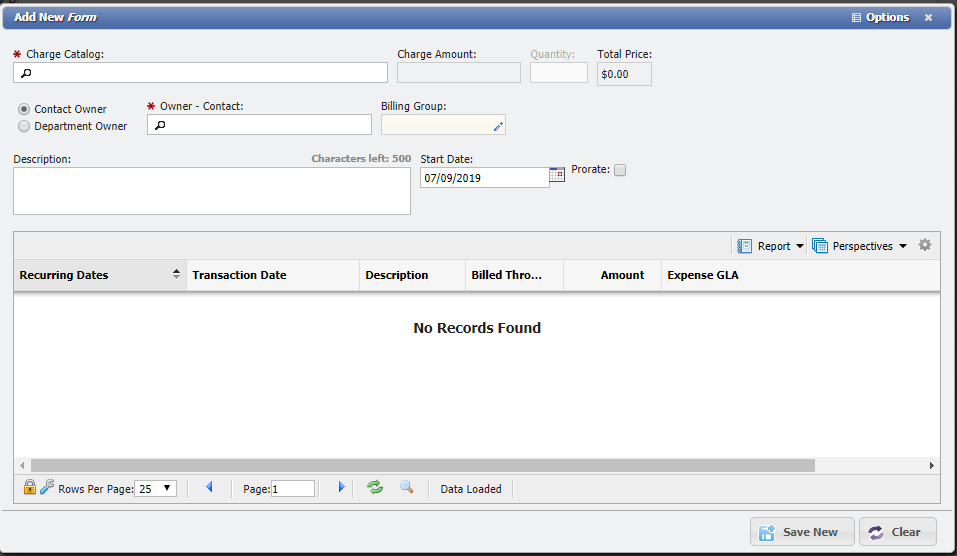
Add New GLA Charges form
There 'Owner' and the 'Charge Catalog' are required fields. A description is highly recommended for tracking. The User can select to prorate the charges or not based on billing needs. Once saved the Charge(s) will be the default Charges assigned to the GLA.
Editing
The
Note: Because the Charge is directly associated with the GLA, there is no need for a Default Expense GLA to be supplied before charges can be added.
Deleting/Stopping
It is sometimes necessary to manually delete or stop a charge. There are certain restrictions in place to prevent deleting charges that have been billed. After clicking the

Confirm Delete dialogue
When stopping a charge, click the

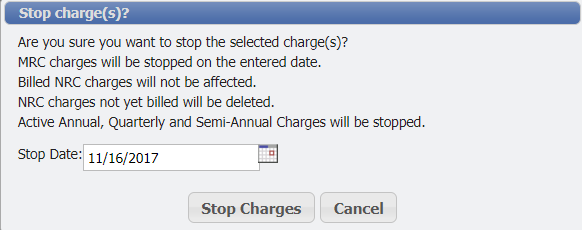
Stop Charges dialogue
Applying an Alternate Recurring Charge
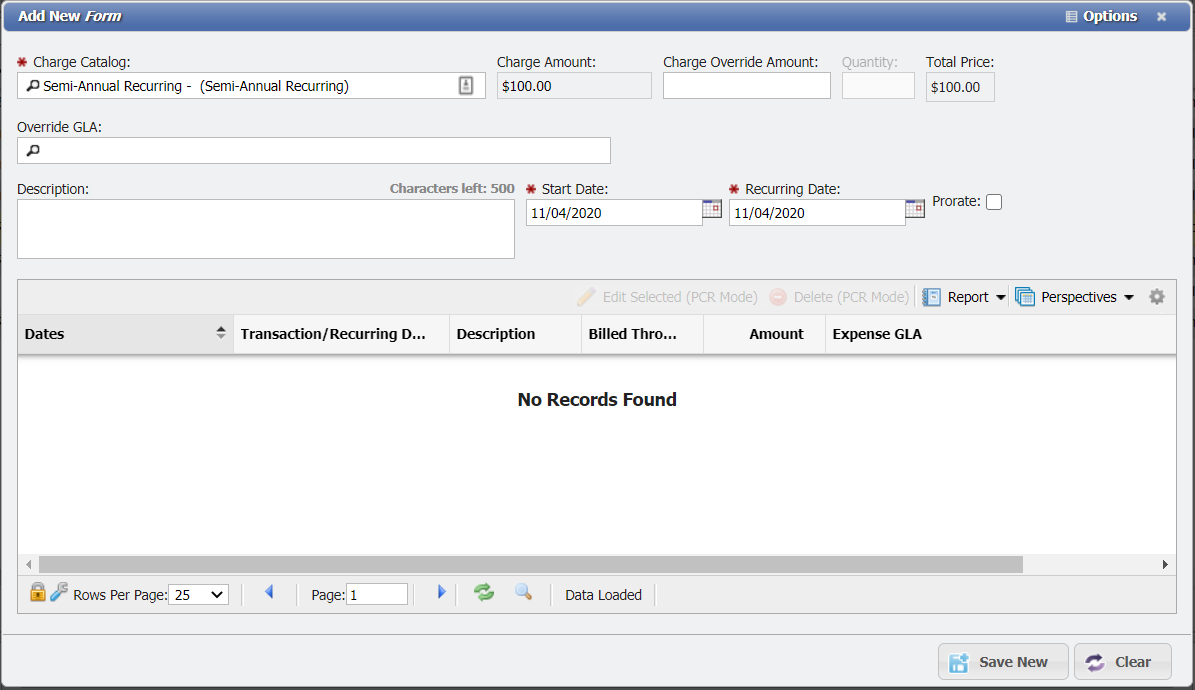
Alternate Recurring Charge Example
When an Alternate Recurring Charge is selected as the Charge Catalog (Quarterly, Semi-Annual and Annual Charges) for a new Charge, the form gains the addition of a Recurring Date field. This is the date that will be used by the Billing Process to determine which Bills the Charge should display on. The Recurring Date can not occur after the Start Date.
Contacts
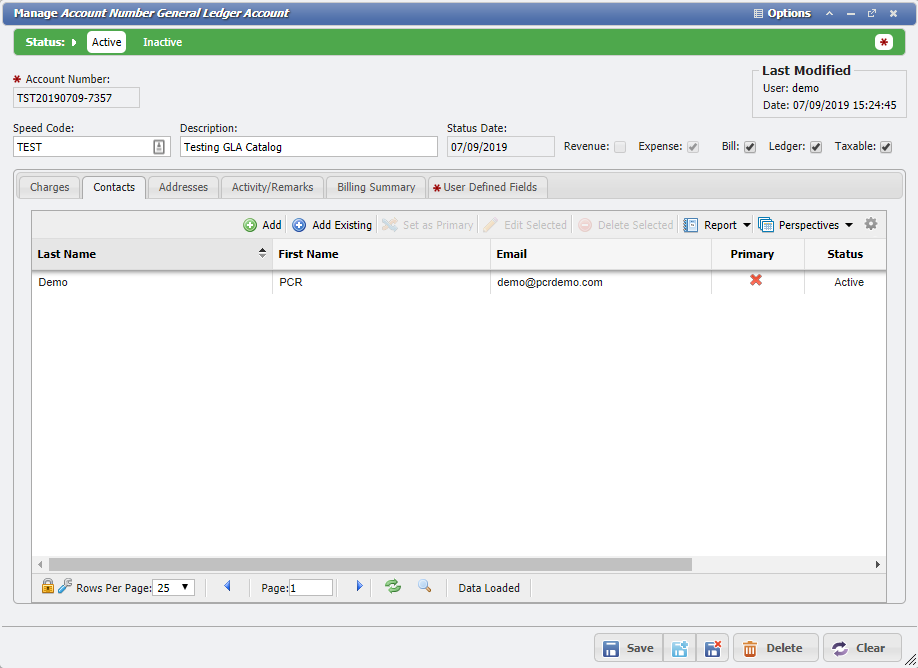
Contacts Tab
The Contacts tab provides the User the ability to manually associate Contacts with each GLA. These associated Contacts represent people who may be responsible for a given budget, or just assigned for billing purposes. These Contact(s) are separate entries in the Workers/Contacts section of the application and are associated with the GLA for tracking purposes.
The User can manually manage these associations by using the 'Add', 'Add Existing', and 'Delete Selected' functionality available on the Contacts tab.
Adding New Contacts
After clicking on the UNKNOWN ATTACHMENTbutton, the User is presented with a data-entry form used to build a basic Contact: First and Last Name, Email, and Phone Number. Adding a new Contact here will create a new record in the Workers/Contacts section of the application.
Adding Existing Contacts
After clicking the UNKNOWN ATTACHMENT button, a list of existing contacts is presented. Contacts can be associated with multiple GLAs. As such, this list will display all Active Contacts in the system. Searching through this list and selecting multiple entries will allow the User add all the required Contacts. Check each of the Contacts that need to be associated with the GLA and click the
Set a Primary Contact
The Primary Contact is the person responsible for a given GLA and is required on GLAs. If the GLA is created without a Primary Contact, then when a Payment is created, the resulting Charge will not have an owner and cannot be billed. Primary Contacts are required for Service Fees. The Primary Contact is also used as the "Bill to" person on Invoices (although the address is actually the Billing address on the GLA). Setting this will route Billing to that Contact as well as aid in quick identification of the primary point of contact. Simply select the Contact that should be Primary and click the
Note: There can only be one Primary Contact on any given record.
Edit Selected
Selecting the

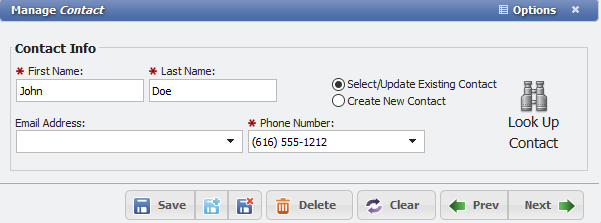
From here, the User can modify the information associated with the Contact and save the information back onto the grid.
Delete Selected
Selecting the

Addresses
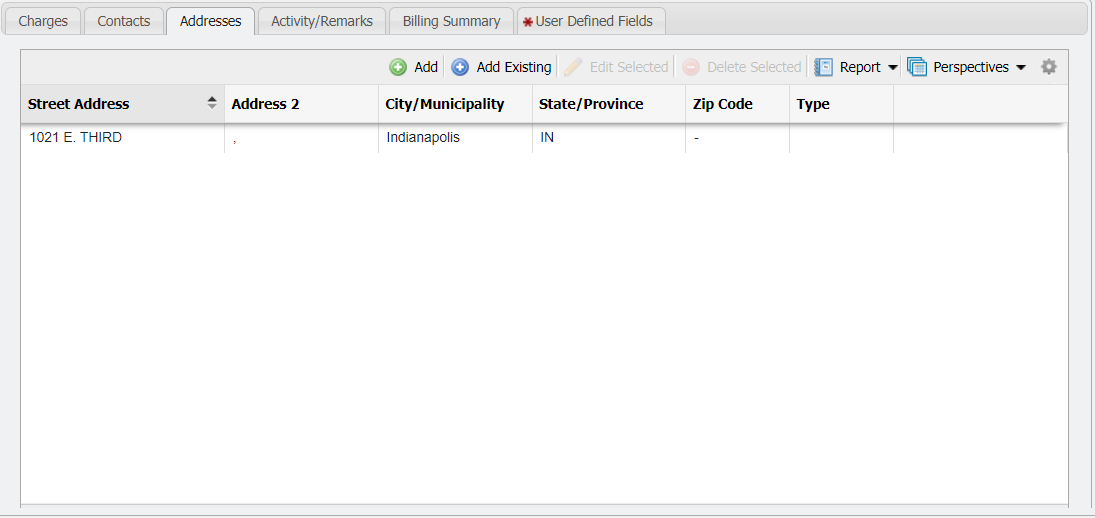
Addresses Tab example
The 'Addresses' tab is specific to the GLA Catalog. When an Address is associated with a GLA in this manner, the Billing Address will be set for the given GLA.
A User can either use the

GLA Activity/Remarks Tab
Activity/Remarks
Add Remark
Remarks are useful for making notes about a Return Order that might need to be recalled in the future. To add a Remark, follow these steps:
Click the
 button.
button.This will open the 'Add New Remark' form.
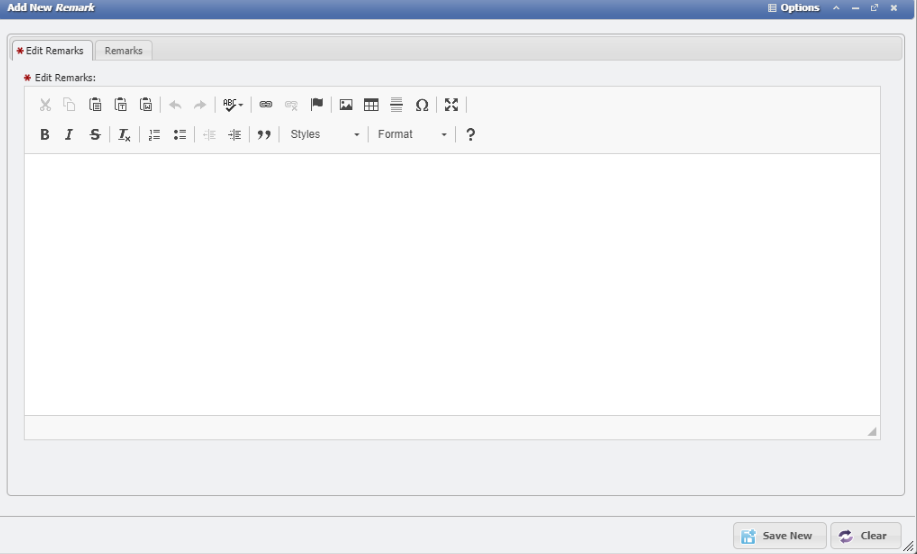
Enter the Remarks desired into the field.
Click the 'Save New'
 button.
button.
The Remark will be added to the list along with a User ID and time stamp for tracking.
View/Edit Remarks
Double-click or select the ![]() button to open the Remark.
button to open the Remark.
The form will open so the User can read all the content of a given Remark.
Click the
 button to commit any changes made to the Remark.
button to commit any changes made to the Remark.
Delete Selected
Clicking the ![]() button will delete any existing Remark.
button will delete any existing Remark.
Note: Remember, depending on the System Configuration, remarks may not be editable once added.
Billing Summary
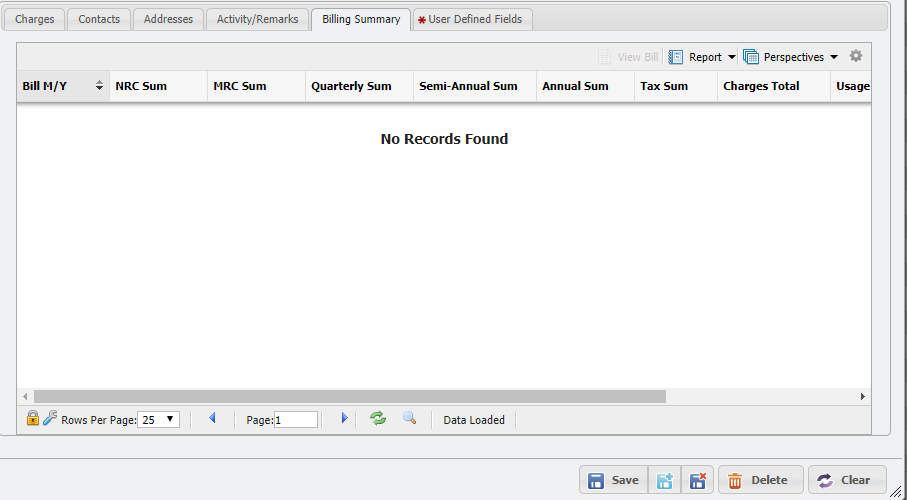
The 'Billing Summary' tab is specific to the GLA Catalog. From this tab, the User can access the Bill for a given GLA.
Select the Bill to view from the Grid.
Click the
 button.
button.The Bill will open in a new tab will all the relevant data.
From the tab, the User can then View, Print, or save the Bill in a .pdf file format.
Attachments
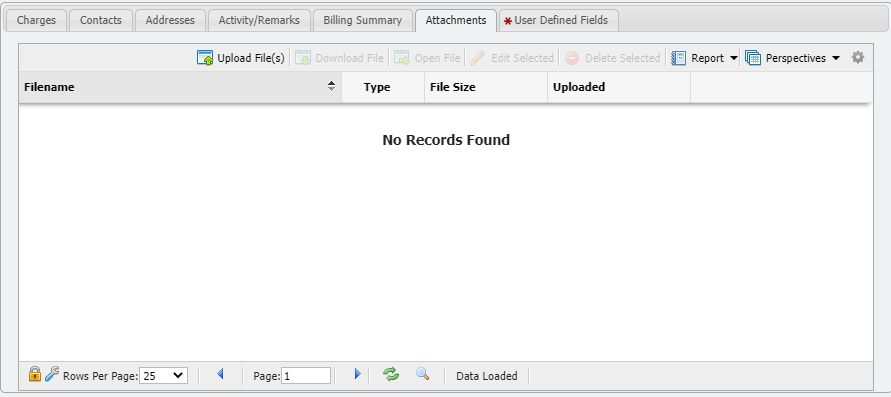
GLA Attachments Tab Example
The Attachments tab allows Users to attach files (including .pdf, .jpg, .doc, and more) of interest or relevance to the Department by uploading them into PCR-360.
Uploading a File
To attach one or more files, navigate to the 'Attachments' tab and click the

Download File
Allows a User to download a file to their local machine. Useful to make modifications to a file, which can then be re-uploaded. To download a file click the

Open File
This will open the file, if possible, for viewing by the User. No modifications of the original file can be made when opened in this manner. To use this functionality select the file to view and click the

Edit Selected
Allows the name of the file to be modified within PCR-360. If a User modifies the name of the file, that is the new name that will be used when downloading the file.
1. Select the file to modify and click the

2. This will open the 'Manage Attachment' form.

Manage Attachment form
From here the filename can be modified as desired.
Note: Care should be taken NOT to change the extension of the file name or unexpected behaviors or lose of the file are possible.
Delete Selected
This will remove the file from PCR-360. Select the file to remove and click the

User Defined Fields
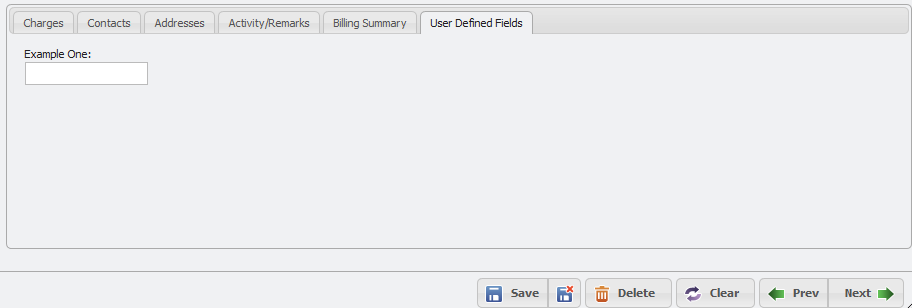
The 'User Defined Fields' tab will only be visible if there are User Defined Fields that are set on the User Defined Fields. Any User Defined Fields that are set will appear on this tab.
